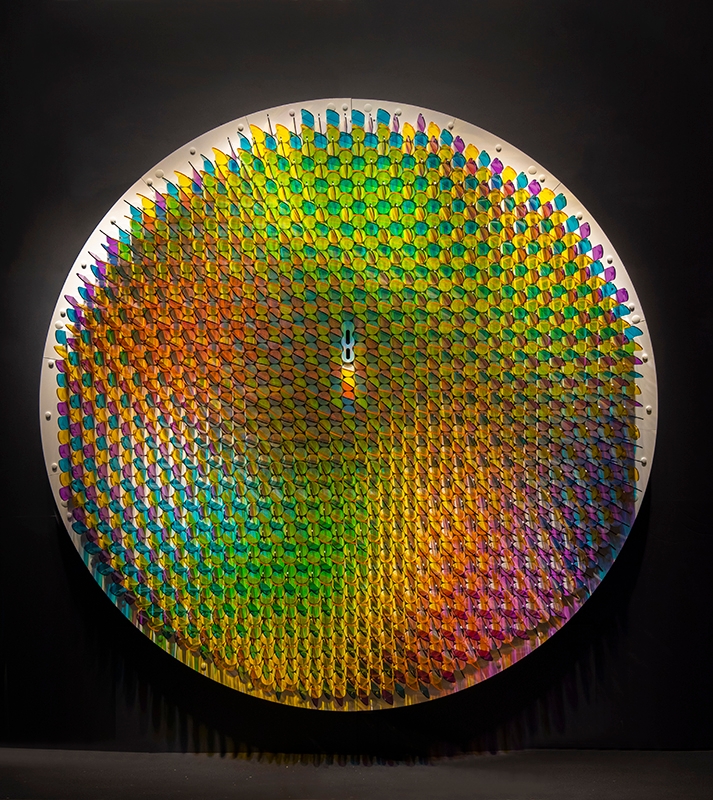ITP/IMA's faculty member, Daniel Rozin, presents his exibition Shades which encapsulates Rozin’s investigation into Mechanical Mirrors, a series that began in 1999 with Wooden Mirror. The exhibition debuts the artist’s implementation of full color spectrum mechanical mirrors using the color models RGB (red, green, blue) and CMY (cyan, magenta, yellow).
bitforms gallery
131 Allen Street
New York, NY 10002
Opening reception: Thursday, March 17, 6–8 PM
Exhibition Dates: March 17–April 23, 2022
Gallery hours: Tuesday–Saturday: 11 AM–6 PM
Masks and Proof of Vaccination are required for entry into gallery
Daniel Rozin’s practice has investigated the nuance of reflected portraiture and mechanical choreography for nearly three decades. In his latest exhibition, the artist pairs the evanescent experience of live image creation with a variety of new materials. Rozin implements a masterful manipulation of light and shadow to create complex, dynamic images.
The artist is an expert when it comes to uncanny materials—a challenge he implements as an artistic constraint. In Chopstick Mirror Rozin refigures a familiar dining utensil into an element of representation. Although the artwork is intrinsically mechanical, it attempts to display the viewer by echoing the fluidity of their motion. The resulting depictions are interactive images investigated through the constraint of one-dimensional linear objects. This piece acts as an experiment beyond the mirror, inviting reactions from the piece itself, such as gestures of friendliness, surprise, and coyness, in addition to generative routines and sonic compositions.
Shades encapsulates Rozin’s investigation into Mechanical Mirrors, a series that began in 1999 with Wooden Mirror. The exhibition debuts the artist’s implementation of full color spectrum mechanical mirrors using the color models RGB (red, green, blue) and CMY (cyan, magenta, yellow). Almost seven years years in the making, Rozin began conceptualizing color production by means of an optical manipulation of light and shadow. His mechanical pieces up to this date have reproduced a black and white or grayscale reflection—producing color is a complex challenge. The mechanical mirrors exhibited in Shades create a mediated viewing experience of reflection through diverse materials. Rozin examines how light and shadow coalesce through his mastery of image creation.
RGB Peg Mirror is Rozin’s first mirror capable of reproducing viewer reflections in full color. The artist programmed red, green, and blue colored knobs to tilt towards the light, controlling their reflected color, thus allowing the recreation of a full color portrait. RGB color models are largely used within electronics, TVs, and monitors to create a combined display for a wide array of colors. Rozin’s CMY Shadows Mirror employs the inverse tactic. This piece uses a subtractive color model, typically employed in printing, to selectively mask light that would otherwise be visible. Both mirrors are shown in an interactive period where the viewer is reflected as well as a programmed choreography of undulating, vibrant colors. This exhibition is the first occasion for these full color mirrors to be shown in conversation.
Plant Mirror is the latest in the Mechanical Mirror series, a body of work that the artist has been focused on for over two decades. This newest work speaks to its title both in the material it uses, a live Philodendron plant, and in its reflection of a second plant. Rozin situates a potted plant on the wall above an armature that houses motors and electronics. The branches drape over the armature, allowing their leaves to connect to motors that tilt them up and down. A second potted plant is positioned on a pedestal and connected to sensors that monitor light, humidity, and CO2 levels; any change in the measurements of these attributes causes the display plant to respond. The light level of the plant is reflected by the display leaves tilting up and down in slow correspondence. Breathing on the plant elevates its CO2, inciting a pulsing momentum like a heartbeat, until the levels recede. Humidity changes are celebrated on the display plant as a joyful, choreographed wave. Rozin frequently takes inspiration from nature and science for many of the Mechanical Mirror works, incorporating wood, fur, mud and rust, as well as optics, light and time. Plant Mirror observes the viewer’s relationship to nature from the perspective of a plant. What is the significance of a human presence in terms of air quality, light level, and nourishment? What does it mean to interact with a mechanical digital system indirectly, one that is mediated by a plant?
